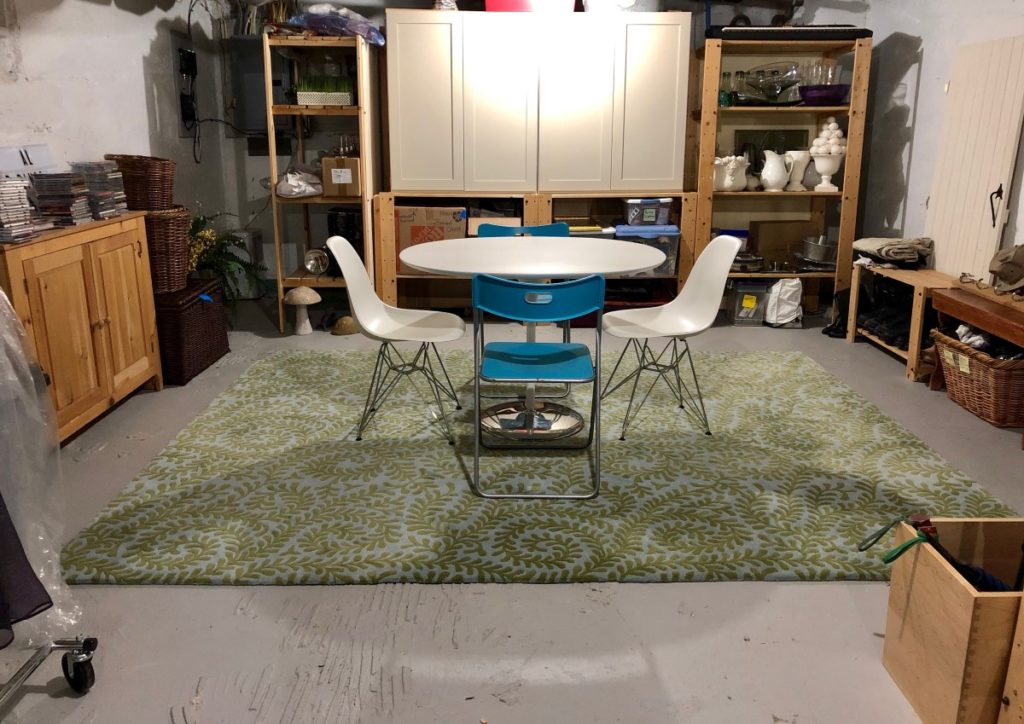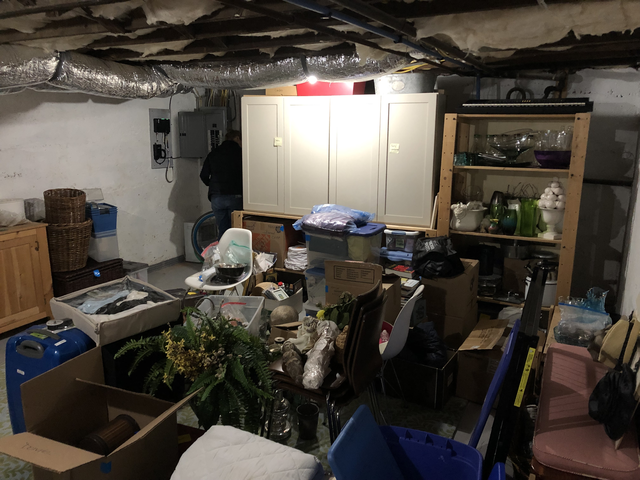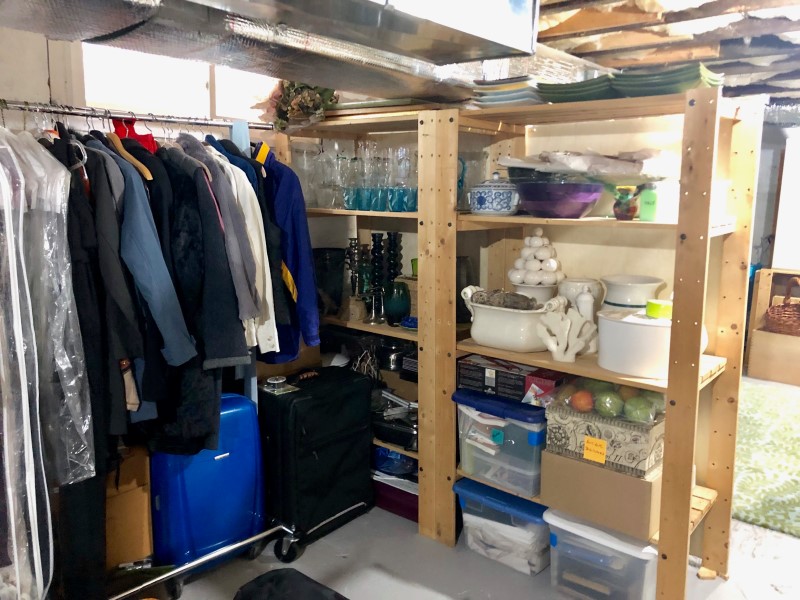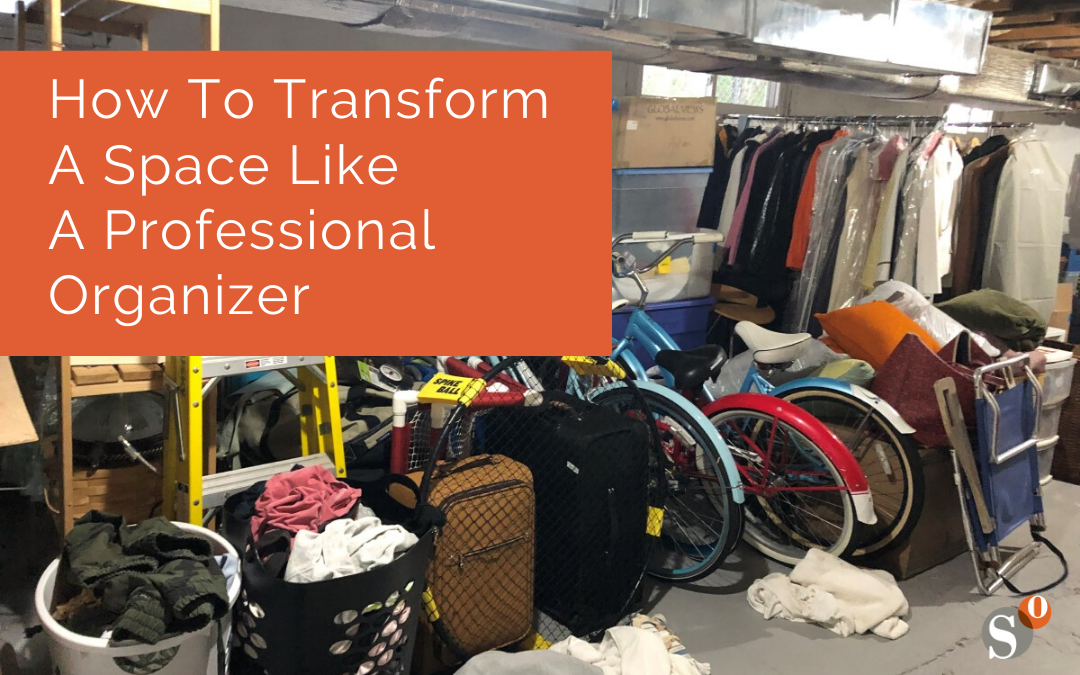Have you ever wanted to change the purpose of a room or transform a space in your home? Eke out more living space by dressing up that unfinished area to feel cozier? Or, tackle a full renovation of that unfinished space?
I’ve done all three in my home and I love when clients call with a project to transform a space. These projects are super fun because we get to re-imagine how the furniture is used, spaces are arranged, and the stuff is organized. The results can be amazing.
We recently worked with a long time client who downsized to a smaller home with a clean and bright unfinished basement.
 Originally, we transformed this space setting up space for storage and laundry. Using leftover cabinets from the kitchen renovation, existing shelves, and a fun colorful rug, we set up beautiful storage space. We unpacked and organized her overflow kitchen and decorative items so she could easily access them. She could “shop” this basement storage area as she decorated her new home upstairs.
Originally, we transformed this space setting up space for storage and laundry. Using leftover cabinets from the kitchen renovation, existing shelves, and a fun colorful rug, we set up beautiful storage space. We unpacked and organized her overflow kitchen and decorative items so she could easily access them. She could “shop” this basement storage area as she decorated her new home upstairs.
 Over time, however, space filled up with more stuff, as is common. The once organized space became disorganized and needed some attention.
Over time, however, space filled up with more stuff, as is common. The once organized space became disorganized and needed some attention.
At the same time, she realized she needed a hang out space for her college-aged children and their friends. Where could she eke out and transform the space?
 Well, you guessed it. She could divide the space and create multiple zones. And, that’s when she gave us a call. She had a vision and wanted some hands-on help to reconfigure the space. Our team rolled up our sleeves and got busy.
Well, you guessed it. She could divide the space and create multiple zones. And, that’s when she gave us a call. She had a vision and wanted some hands-on help to reconfigure the space. Our team rolled up our sleeves and got busy.
We made great progress with her transformation and look forward to completing it in the near future.
In the meantime, here are a few tips if you’re considering transforming a space in your home.
Define the goal of the project:
Clearly articulating your goal and vision will enable you and your team to move in the same direction. Brainstorming options will lead to the right solutions to transform a space. In this case, our client envisioned comfy seating, a TV, and a cool vibe with string lights and a dark ceiling. That’s what we’re working towards.
Create space first:
If your target takeover area is chock full of stuff, start by editing and consolidating so you have space to actually work. Can items be removed entirely or relocated elsewhere in the house? It’s difficult to see through the clutter and super hard to safely rearrange if the floor is covered or shelves are stacked. For our client, we edited items for donation, collected books for a library book sale, and condensed memorabilia for easier storage. Can you link to your current blog with this phrase?
Identify what’s usable:
Once you’ve freed up space you can see what you have but also how you can reuse it. Most of my clients are trying to repurpose furniture they already have so we spend time brainstorming how a piece could be repositioned and repurposed. For example, a TV armoire can become storage for craft supplies, a bench can be repositioned as a coffee table, a dresser can be used as a TV stand.
Shop your house:
You may be working in the basement but something elsewhere in your house could provide the perfect solution. Seeing new opportunities for existing pieces can be challenging. A fresh set of eyes from your organizer can help with this. For our client, we may use some low shelving to create an island for folding laundry.
Plan your layout:
There are generally some constraints that drive the layout. Doors, windows, stairs, ductwork, and natural pathways, to name a few. Talk it out. Measure. Sometimes the craziest ideas lead to the perfect solution. Use placeholders before moving large or heavy pieces to test options.
Create your zones:
Zones are broad areas for storage or activities. The relaxing zone, laundry zone, the sports equipment zone, the exercise zone.
Don’t worry about where everything will live:
Most folks want to know exactly where things will be placed before we start, but in many organizing projects it’s a process of trial and error. Start with general zones and an understanding of available space vs. what you need to store and go from there. We find that obvious factors often dictate the final storage home.
Move back in:
This is the actual process of placing items. How will they be contained? What needs to be most accessible? What containers are needed? Uniformity and labeling go a long way to reducing visual clutter and making the storage space attractive.
Does this type of project seem beyond your reach? It may be a bit intimidating if you’ve never done it before or feel like you don’t have a creative eye. Repurposing a room or two in your home is worth the effort–especially if you have help! Have a room in mind you’re looking to transform and repurpose? Don’t keep pushing it to the “maybe later” list- reach out and let’s chat about it.
Want more tips like these, visit us on facebook and instagram, where I share weekly tips on staying smartly organized.


